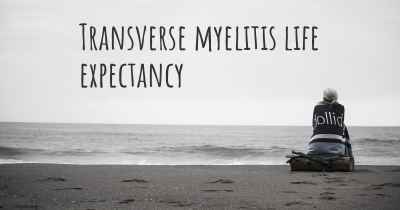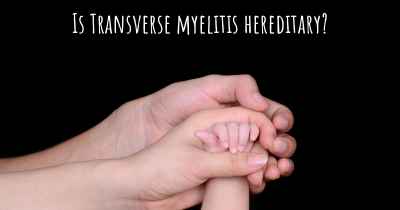7
Living with Transverse myelitis. How to live with Transverse myelitis?
Can you be happy living with Transverse myelitis? What do you have to do to be happy with Transverse myelitis? Living with Transverse myelitis can be difficult, but you have to fight to try to be happy. Have a look at things that other people have done to be happy with Transverse myelitis

Rehabilitative and long-term therapy
Many forms of long-term rehabilitative therapy are available for people who have disabilities resulting from transverse myelitis. Strength and functioning may improve with rehabilitative services, even years after the initial episode. Although rehabilitation cannot reverse the physical damage resulting from transverse myelitis, it can help people, even those with severe paralysis, become as functionally independent as possible and attain the best possible quality of life.
Common neurological deficits resulting from transverse myelitis include incontinence, chronic pain, and severe weakness, spasticity, or paralysis. In some cases, these may be permanent. Individuals with lasting or permanent neurological defects from transverse myelitis typically consult with a range of rehabilitation specialists, which may include physiatrists, physical therapists, occupational therapists, vocational therapists, and mental health care professionals.
Physical therapy can help retain muscle strength and flexibility, improve coordination, reduce spasticity, regain greater control over bladder and bowel function, and increase joint movement. Individuals are also taught to use assistive devices such as wheelchairs, canes, or braces.
Occupational therapy teaches people new ways to maintain or rebuild their independence by participating in meaningful, self-directed, everyday tasks such as bathing, dressing, preparing meals, and house cleaning.
Vocational therapy involves offering instructions to help people develop and promote work skills, identify potential employers, and assist in job searches. Vocational therapists act as mediators between employees and employers to secure reasonable workplace accommodations.
Psychotherapy for people living with permanent includes strategies and tools to deal with stress and a wide range of emotions and behaviors.
Many forms of long-term rehabilitative therapy are available for people who have disabilities resulting from transverse myelitis. Strength and functioning may improve with rehabilitative services, even years after the initial episode. Although rehabilitation cannot reverse the physical damage resulting from transverse myelitis, it can help people, even those with severe paralysis, become as functionally independent as possible and attain the best possible quality of life.
Common neurological deficits resulting from transverse myelitis include incontinence, chronic pain, and severe weakness, spasticity, or paralysis. In some cases, these may be permanent. Individuals with lasting or permanent neurological defects from transverse myelitis typically consult with a range of rehabilitation specialists, which may include physiatrists, physical therapists, occupational therapists, vocational therapists, and mental health care professionals.
Physical therapy can help retain muscle strength and flexibility, improve coordination, reduce spasticity, regain greater control over bladder and bowel function, and increase joint movement. Individuals are also taught to use assistive devices such as wheelchairs, canes, or braces.
Occupational therapy teaches people new ways to maintain or rebuild their independence by participating in meaningful, self-directed, everyday tasks such as bathing, dressing, preparing meals, and house cleaning.
Vocational therapy involves offering instructions to help people develop and promote work skills, identify potential employers, and assist in job searches. Vocational therapists act as mediators between employees and employers to secure reasonable workplace accommodations.
Psychotherapy for people living with permanent includes strategies and tools to deal with stress and a wide range of emotions and behaviors.
Posted Aug 16, 2022 by Transverse Myelitis Folks Blue Crew
I believe people can learn to live a happy life however the constant need to overcome and get up everyday to fight the same battle thought yesterday or 24 hours a day takes its toll emotionally it's really important to seek counseling some have found antidepressants have helped as well. I will say that having a support system is the most crucial piece and because of the lack of understanding of transverse myelitis many if not most don't get the support that they need from friends and family community even medical community. I found the public and a private group on Facebook that I communicate with members throughout my day everyday so that I feel the others can relate to me and what I'm going through so I can be inspired and encouraged and provide that theirs as well. I've discovered a research study that was recently published and there are two pages of just the authors who correlated on this Pacific report on all myelitis types of diseases knowledge is power and that power enables you to move forward to accept what is and therefore allows you to move forward emotionally from the devastation and the lost that you feel when you are diagnosed with transverse myelitis and suffer from its effects. Personally I have found that if I wake every morning and watch the sunrise and listen to The Birds and the squirrels and connect with nature it helps me to feel centered and positive so that I can persevere through my day and in many of my conversations with others they also use methods like this meditation has become incredibly important every day as well as music therapy. I discovered 432 Hertz tuning music to set myself a higher vibration therefore giving you a little bit more energy today to come back the effects from TM
Posted Feb 23, 2017 by Jen 1001
If you get this then , you have to learn to accept it and live with it! The best way is just to take one day at a time
Posted Feb 23, 2017 by Cathy 1000
Being given a diagnosis of TM can be life changing and may cause anxiety and depression. I would advise surrounding yourself with positive people and try to live your life as normally as possible. If work is no longer possible then try to follow hobbies and pastimes, but try to get out and be with other people as much as you can.
My own hobbies are crochet, knitting and patchwork, I try to get to my knit and better sessions as much as possible. I use a mobility scooter to get there although I have plenty of offers of lifts if the weathers bad for example. Keep positive, be as independent as you can but don't be shy about asking for help.
Invite friends round for a cuppa and a chat, most people will ask "is there anything I can do?" Well say "yes" or if there isn't ask if you can call them if you need a lift to the doctors or will they take you to the supermarket next time they are going....build a support network around you.
Finally I would advise practicing mindfulness and meditation. Be grateful for the things you have and learn to accept the 'new you'. Again, joining in a group is beneficial.
My own hobbies are crochet, knitting and patchwork, I try to get to my knit and better sessions as much as possible. I use a mobility scooter to get there although I have plenty of offers of lifts if the weathers bad for example. Keep positive, be as independent as you can but don't be shy about asking for help.
Invite friends round for a cuppa and a chat, most people will ask "is there anything I can do?" Well say "yes" or if there isn't ask if you can call them if you need a lift to the doctors or will they take you to the supermarket next time they are going....build a support network around you.
Finally I would advise practicing mindfulness and meditation. Be grateful for the things you have and learn to accept the 'new you'. Again, joining in a group is beneficial.
Posted May 17, 2017 by Marella Cairns 1050
Don't let this beat you down. There have been many times depression has set in and you have to remind yourself why you keep going. There is so much more to see and do and that YOU still deserve to do those things. You may need to confide in someone for support and that's okay.
Posted May 17, 2017 by Justin 1152
All I can say is that you have to make the best of your situation. This is not easy but if you don't then you will not be happy & those around you will also be unhappy. Have a positive mental attitude & try to wear a smile & try to make that smile come from the inside.
Posted Jul 24, 2017 by Hagen 2730
Singing made me happy, reduced my pain, but that's just me.
Posted Jul 25, 2017 by Mindy 2000
A positive attitude is best. Avoid things that would make you negative and focus on your abilities rather than your disabilities. Find new ways to do the things you can't do anymore and new activities.
Posted Jul 25, 2017 by Conrad 2200
Yes you can live a happy life with TM. The best thing to do is accept the fact you have a medical disabily and might have to do things a littls differently then what you were used to. I also know my faith in Jesus Christ and my God helps me get through this daily.
Posted Aug 24, 2017 by Elizabeth 1200
Yes you can be happy living with TM! Lifestyle adjustments can occur but become your new daily life. Look to the future and find the good within your life. Many other individuals have it much worse than we do with TM.
Posted Sep 29, 2017 by Samantha Bryce 2065
Happiness is a state of mind so yes, you can be happy with TM if you can keep a positive attitude, learn your limitations and keep a sense of humor. Understanding what TM is/does also helps. If you stop working, discover some hobbies like gardening or anything you enjoy.
Posted Oct 6, 2017 by Chuck 2000
Excercise plenty, and concentrate on anything that promotes a positive mental attitude.
Posted Nov 30, 2017 by mikado54mark 3150
I haven’t met anyone yet who is happy living with Transverse Myelitis but we all must make the most of what we are given. Like everything in life we do our best and I have met a great deal of people with the condition and we all seem to just get on with it. The key is to get as much information as possible to suit your own needs.
Posted Feb 27, 2018 by Gill 1800
Living with TM is a daily struggle and there is no getting around that. I never knew I was capable of the mental toughness it takes to live with a disease such as this. BUT...you DO learn to make accommodations and push through the pain. My recovery is on-going and I've accepted it will be for the rest of my life. I'm fortunate to have a sympathetic partner who has seen me at my worst and knows when to tell me to slow down. I was physically and emotionally devastated in the months following my diagnosis, but it DOES get better. Have HOPE!
Posted Mar 22, 2018 by Amy 100
Do the exercises everyday. Always keep fighting it. Also, try and carry on your regular life, like vacationing, working, going out to dinner, wheelchair hiking, etc. Beat transverse myelitis, don't let it beat you.
Posted Jun 1, 2018 by Clay Garner 2500
You have to accept it as your new norm and respect it but don't fear it and fight each battle with a vengeance and understand it will flare up again and again.
Posted Jun 1, 2021 by Gary 3550
Rehabilitative and long-term therapy
Many forms of long-term rehabilitative therapy are available for people who have disabilities resulting from transverse myelitis. Strength and functioning may improve with rehabilitative services, even years after the initial episode. Although rehabilitation cannot reverse the physical damage resulting from transverse myelitis, it can help people, even those with severe paralysis, become as functionally independent as possible and attain the best possible quality of life.
Common neurological deficits resulting from transverse myelitis include incontinence, chronic pain, and severe weakness, spasticity, or paralysis. In some cases, these may be permanent. Individuals with lasting or permanent neurological defects from transverse myelitis typically consult with a range of rehabilitation specialists, which may include physiatrists, physical therapists, occupational therapists, vocational therapists, and mental health care professionals.
Physical therapy can help retain muscle strength and flexibility, improve coordination, reduce spasticity, regain greater control over bladder and bowel function, and increase joint movement. Individuals are also taught to use assistive devices such as wheelchairs, canes, or braces.
Occupational therapy teaches people new ways to maintain or rebuild their independence by participating in meaningful, self-directed, everyday tasks such as bathing, dressing, preparing meals, and house cleaning.
Vocational therapy involves offering instructions to help people develop and promote work skills, identify potential employers, and assist in job searches. Vocational therapists act as mediators between employees and employers to secure reasonable workplace accommodations.
Psychotherapy for people living with permanent includes strategies and tools to deal with stress and a wide range of emotions and behaviors.
Many forms of long-term rehabilitative therapy are available for people who have disabilities resulting from transverse myelitis. Strength and functioning may improve with rehabilitative services, even years after the initial episode. Although rehabilitation cannot reverse the physical damage resulting from transverse myelitis, it can help people, even those with severe paralysis, become as functionally independent as possible and attain the best possible quality of life.
Common neurological deficits resulting from transverse myelitis include incontinence, chronic pain, and severe weakness, spasticity, or paralysis. In some cases, these may be permanent. Individuals with lasting or permanent neurological defects from transverse myelitis typically consult with a range of rehabilitation specialists, which may include physiatrists, physical therapists, occupational therapists, vocational therapists, and mental health care professionals.
Physical therapy can help retain muscle strength and flexibility, improve coordination, reduce spasticity, regain greater control over bladder and bowel function, and increase joint movement. Individuals are also taught to use assistive devices such as wheelchairs, canes, or braces.
Occupational therapy teaches people new ways to maintain or rebuild their independence by participating in meaningful, self-directed, everyday tasks such as bathing, dressing, preparing meals, and house cleaning.
Vocational therapy involves offering instructions to help people develop and promote work skills, identify potential employers, and assist in job searches. Vocational therapists act as mediators between employees and employers to secure reasonable workplace accommodations.
Psychotherapy for people living with permanent includes strategies and tools to deal with stress and a wide range of emotions and behaviors.
Posted Aug 17, 2022 by Kevin Weilacher 3420
Recovery from TM varies greatly. Some people have no or slight recovery. Some people have a great deal of recovery, although I don't know if anyone ever gets back to 100%.
Posted Aug 17, 2022 by gloria_kazan 7450
Translated from spanish
Improve translation
You can . You have to accept the limitations and that some things have changed and adapt to them. The disease can be a beginning for another way of life, or do things that we had ppstergado
Posted May 29, 2017 by Adriana E. 2000
Translated from spanish
Improve translation
There is No greater disability than the lack of love. You learn to tolerate, manage time and frustration.
Posted May 29, 2017 by Leandro 2200
Translated from spanish
Improve translation
Your quality of life will depend on the sequels. You can be happy but it is more complicated
Posted Aug 8, 2017 by Dani 2000
Translated from spanish
Improve translation
A common life and power, as well as another person who does not have transverse myelitis
Posted Sep 14, 2017 by Franci 2000
Translated from spanish
Improve translation
With patience, you can not be happy with pain . I am still discovering what to do to live happy as well
Posted Nov 8, 2017 by Lorena 3050
Translated from spanish
Improve translation
If, with resignation and a good temple
Posted Nov 12, 2017 by Carlos 500








